Dive in the Maldives - 26 Atolls
So Many Islands, So Many Choices
With nearly 2,000 islands, most of which are uninhabited, the Maldives has countless stories to tell. The islands are scattered throughout the Arabian Sea, lying south of India and Sri Lanka. Off of the white sand beaches, the waters invite guests into a new world. With pelagic life, nutrient-rich waters, and abundant coral, the Maldives provides a great experience for any diver, no matter their ability. Most notably, however, are the 26 lively atolls that bring visitors to the islands. Each atoll is unique, and there is a variety of adventures for divers to choose from. Each one of the Maldives atolls has a unique history and vibrancy that is just waiting to be explored. With countless different dive sites and extensive marine life, divers can’t go wrong when choosing to spend their time in the Maldives.
Ihavandhippolhu Atoll - Located at the very top of the Maldives, Ihavandhippolhu Atoll has many amazing sights for divers. Channels in this area are wider and shallower when compared to others in the Maldives, making the currents calmer and better for newer divers. This location has many walls and overhangs as well as macro life. Some guests even spot larger marine life such as reef sharks and turtles. One of the most popular resorts on the atoll is Beach House Iruveli, which has access to a five-star diving center.
Haa Alif
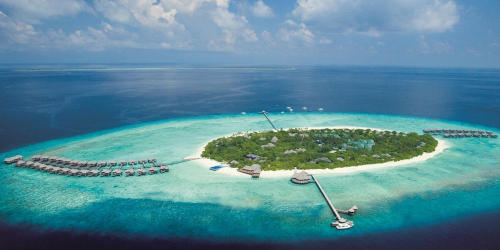
Thiladhunmathi - Also known as Haa Alif Atoll, is the farthest north atoll in the Maldives as well as one of the largest atolls in the world. With forty-three islands of varying sizes, this atoll has only been open to tourism for less than 20 years. Only fourteen of the islands are inhabited. In addition to this, the western side has separate isolated reefs and tiny atolls within the atoll. Guests usually visit this location if they are looking to spend their days on the beach and exploring all that the sea has to offer. Haa Alif is a 70-minute seaplane ride from the Male Airport, and there is a new airport, Hoarafushi Airport, on the atoll as well. Photo courtesy of CruiseMapper.
Maamakunudhoo - As a small and intimate atoll, Maamakunudhoo has plenty of history that lives in its waters. There are many shipwrecks near its coral reef, and the marine life is plentiful. Divers often get to see jellyfish, dolphins, eels, and more on their adventures. Only one of the four islands in this atoll is inhabited as the atoll wasn’t known to exist until the 1800s.
Etthingili Alifushi - Consisting of only two islands that lie on a detached reef, Etthingili Alifushi Atoll is known for its peaceful environment. Only one of the two islands is inhabited, and the waters surrounding them are very deep. There are luxury hotels in which guests can their time, and the natives are known for their carpentry and boat building.
You & Me Resort - Raa Atoll

Raa Atoll - As one of the most popular atolls in the Maldives, Raa Atoll consists of 88 islands, only 15 of which are inhabited. It is located on the northern end of the Maldives and has many luxury hotels to choose from such as Kudafushi, Emerald, and Joali Maldives. Divers often get to see pelagic life and spend their time on comfortable liveaboards as they explore many of the dive sites Raa has to offer. Photo courtesy of You & Me Resort.
Fasdhūetherē - Popular for its island-hopping opportunities, Fasdhūetherē Atoll lies between two atolls in the northern section of the Maldives. It is home to 11 islands, only one of which is inhabited. This atoll is perfect for travelers looking to escape from the hustle and bustle of daily life and fall into tranquility.
Baa Atoll
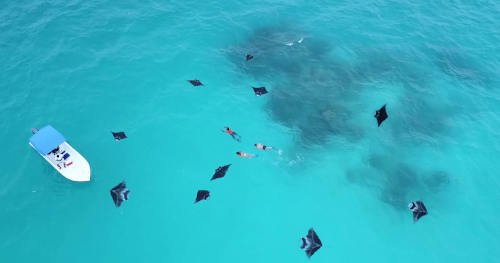
Baa Atoll - Due to its abundant biodiversity, Baa Atoll is a UNESCO Biosphere Reserve. The waters are home to gatherings of manta rays and whale sharks, most often in Hanifaru Bay. Perhaps one of the most popular sites in Baa is the submerged reef known as Dhonfanu Thila where divers can swim deep into the waters and see schools of fish as well as the occasional shark or manta ray. Although this is a more difficult dive, visitors of any skill level can choose from a wide range of dive sites that fits their abilities. Photo courtesy of Visit Maldives.
Goidhu Atoll - As a small oval-shaped atoll with a lagoon free of coral heads, Goidhu has seven islands in total. Only three of the islands are inhabited, but there are still plenty of excursions for visitors to experience. Snorkeling and diving are popular at this atoll, and the lagoon ranges from 30-35 meters deep.
Lhaviyani Atoll - Just a 40-minute seaplane ride north of Male Airport, Lhaviyani Atoll is perfect for any visitor as there are many different resorts to choose from. From adults-only resorts to family-friendly resorts, Lhaviyani truly has it all. Guests looking for a peaceful getaway will be able to find that on this atoll just as others looking for adventure will be able to experience it.
Kaashidhu Atoll - With many coconut trees and its stunning landscape, this atoll has an oval-shaped lagoon and a narrow reef. There are only two islands in the atoll, and there are Buddhist remains from centuries ago. The waters surrounding this atoll are incredibly deep.
Gahaafaru Atoll - With a large reef that has caused many shipwrecks, this small atoll is separated from Male by a deep channel known as Gaafaru Kandu. The lagoon has no coral patches or shoals. There isn’t anywhere to stay on this atoll, but guests still visit this atoll for day trips.
North and South Male Atoll
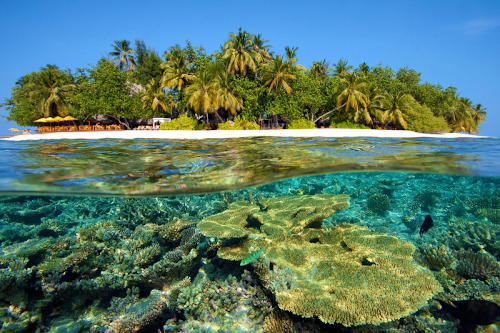
North and South Male Atoll - The Male Atoll comprises two sections: North Male Atoll and South Male Atoll. North Male Atoll is one of the most popular destinations in the Maldives while South Male Atoll is mostly explored by more experienced divers due to its strong currents. North Male Atoll is easily accessed as it is home to the airport, and there is plenty to do, including exploring the capital city or staying at one of the many luxury resorts. South Male Atoll is located near the airport as well and is perfect for guests looking to vacation on a budget. Photo courtesy of ZuBlu.
Thoddu Atoll - With some of the deepest waters in all of the Maldives, Thoddu Atoll is often used for island hopping as there are no real resorts there. There are Buddhist ruins that can be found on parts of the atoll, and the main source of income for those living on Thoddu’s islands is agriculture.
Rasdhu Atoll - Although Rasdhu Atoll may be small, it has plenty of sights to see. Most popular amongst snorkelers and scuba divers, the atoll has a barrier reef stretching along its northern to western sides with another reef to the east. Sightings of hammerhead sharks, manta rays, and turtles are common at this location, and it is usually visited as day trips.
Ari Atoll - The Ari Atoll is located in the western region of the Maldives and is most famous for its stunning clear waters. The atoll is one of the largest in the area, and it has around 50 small islands and several oval reefs. Divers often visit this atoll for the pinnacle, Mayya Thila. This pinnacle reaches a depth of 100 feet, and divers often spot stingrays and barracudas as they descend into the sea. This atoll can be reached by a quick 30-minute seaplane flight from Male airport.
Vaavu Atoll - Situated between South Male Atoll and Meemu Atoll, Vaavu Atoll is home to the ring-shaped Vattaru Reef at its southern end. Most arrive at one of the atoll's five inhabited islands by ferry or speedboat. These trips usually range from around one to three hours. Guests usually visit this atoll for its stunning dive sites, including the Keyodhoo wreck that is only a few years old. There is also a channel with caves and overhangs known as Fotteyo Kandu that bring in many divers each year.
Falhu Atoll - With only one uninhabited islet, Falhu is a very small egg-shaped atoll. Since it is located near the Vattaru Kandu channel, it is often referred to as Vattaru Atoll. This channel is very popular amongst divers due to its diversity and strong currents; however, it can only be reached by boat. Tourists usually don’t visit this atoll due to its small size and the fact that it's uninhabited, but there are many great sights to see in its waters.
Meemu Atoll - With 33 islands in total, Meemu Atoll is located south of Male. While the atoll can be visited by liveaboards, it can also be explored from the comfort of luxury resorts. The islands have plenty of history, including a mosque and a 1573 wreck off of a reef near Kolhuvaariyaafushi Island.
Faafu Atoll
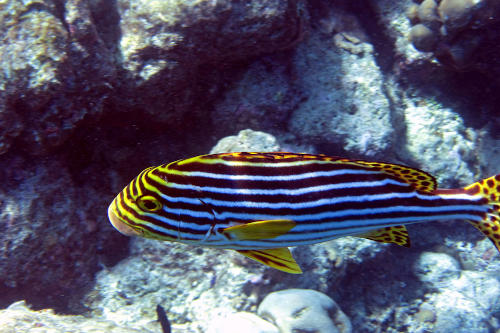
Faafu Atoll - Faafu Atoll is located near the channel Ariadhoo Kandu, which separates it from Ari Atoll. It is often described as peaceful due to its small size and population. Out of the 20 islands that make up this atoll, 15 are uninhabited. This atoll is located just over 100 kilometers from the Male airport. Photo courtesy of the Dive Report.
Dhaalu Atoll - With plenty of luxury resorts to choose from, Dhaalu Atoll is a perfect vacation spot for families and honeymooners. Divers can explore the open lagoon or straight barrier reefs while other visitors can enjoy surfing or snorkeling. 56 islands make up this atoll, and less than 10 of the islands are inhabited. Dhaalu airport is located on the capital island of Kudahuvadhoo and can be reached by flights coming in from Velana International Airport.
Kolhumadulu - Also known as Thaa Atoll, Kolhumadulu is famous for its waters that are ideal for fishing. Buddhism is a large part of the atoll’s history, and there are plenty of Buddhist remains on some of the islands. COMO Maalifushi is the only resort on this atoll.
Haddhunmathi - As one of the more secluded atolls, Haddhunmathi is reached by a short boat ride from Kadhdhoo Airport. Most guests arrive at Kadhdhoo from the Male International Airport. There is one luxury resort on the atoll known as Six Senses. There are plenty of barrier reefs in its waters, some of which even turn into islands. Due to its tropical beauty, the atoll was chosen as the filming location for the Star Wars movie Rogue One.
Huvadhoo Atoll
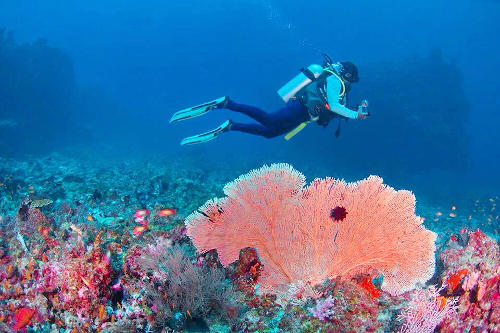
Huvadhoo Atoll - Often referred to as Gaafu, is the second-largest atoll of the Maldives. There are 235 islands in this atoll, and it is surrounded by a rim reef. Many visit this atoll for its ideal surfing conditions, specifically from April to October. Guests can spend their vacation exploring the diverse waters of Gaafu as reef fish, pelagics, and macro life are all common sights for divers. Guests visiting Huvadhoo can experience the atoll at any of the luxury hotels and resorts, or they can visit from several liveaboards.
Fuvahmulah Atoll - Located in the south of the Maldives. Due to its proximity to the equator, there aren’t any seasonal changes that impact diving, so guests are welcome year-round. Most of the dive sites in this area have not been extensively explored, making this location best for more advanced divers. In addition to the pristine, nearly untouched reefs, there are many freshwater lakes as well.
Addu Atoll
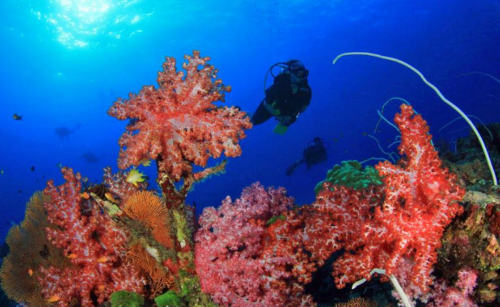
Addu Atoll - Located just south of the equator, Addu Atoll is surrounded by barrier reefs and coral patches in the northern areas. Due to the diverse marine life around the atoll’s reefs, it is a UNESCO Biosphere Reserve. There are 30 islands, 13 of which are inhabited by around 10,000 people. The atoll has a long history, including a dialect that is specific to the area. Photo courtesy of the Scuba News.